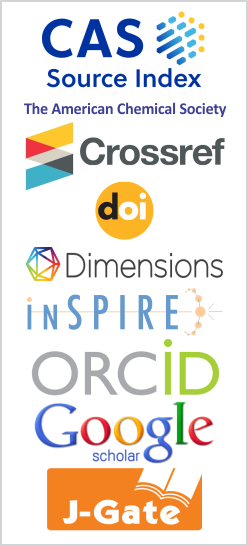Dynamics of Periodically Modulated Cavity Frequency of A Microwave Cavity Consisting of Cold Atoms
DOI:
https://doi.org/10.26713/jamcnp.v1i1.224Keywords:
Cold atoms, Microwave cavity, Two-photon processAbstract
We investigate the possibility to enhance the atomic fluorescence and using it to measure the ‘second' by means of a quantum device formed by two-level cold atoms confined in a microwave cavity with harmonically modulated cavity frequency. Besides the harmonically modulated cavity frequency, we have also studied the modification in the atomic fluorescence due to the addition of the squeezing term in the Hamiltonian of the system. The periodic modulation of cavity frequency give rise to non adiabatic process characterized as two-photon process. It has been observed that the two-photon process can be used as a new handle to enhance the atomic fluorescence which helps in improving the accuracy of the atomic fountain clocks.Downloads
References
M. H. Anderson et al., Science 269, 198 (1995).
C. C. Bradley et al., Phys. Rev. Lett. 75, 1687 (1995).
K. B. Davis et al., Phys. Rev. Lett. 75, 3969 (1995).
F. Biraben, Eur. Phys. J.-Special Topics 172, 109 (2009).
J. Guena et al., IEEE Trans. Ultrason. Ferroelectr. Freq. Control 59, 391 (2012).
I. Bloch, J. Dalibard and W. Zwerger, Rev. Mod. Phys. 80, 885 (2008).
S. Giorgini, L. P. Pitaevskii and S. Stringari, Rev. Mod. Phys. 80, 1215 (2008).
R. Wynands and S. Weyers, Metrologia 42, 64 (2005).
D. M. Meekhof et al., IEEE Trans. Instrum. Meas. 50, 507 (2001).
S. Weyers et al., Metrologia 38, 343 (2001).
L. Marmet et al., Proc. IEEE International Frequency Control Symposium, p. 386 (2008).
K. Szymaniec, W. Chalupezak and D. Henderson, Proc. IEEE International Frequency Control Symposium and PDA Exhibition, p. 112 (2003).
M. Kumagai et al., Proc. IEEE International Frequency Control Symposium and PDA Exhibition, p. 120 (2003).
M. Kumagai et al., Proc. European Frequency and Time Forum 07 (EETF07), Geneva, Switzerland, p. 602 (2007).
Y. T. Kwon et al., IEEE Trans. Instrum. Meas. 52, 263 (2003).
F. Levi et al., Proc. IEEE International Frequency Control Symposium and PDA Exhibition, p. 199 (2003).
A. Clairon et al., IEEE Trans. Instrum. Meas. IM44, 128 (1995).
A. Sen Gupta et al., CPEM 2010 Technical Digest (2010).
K. Gibble and S. Chu, Metrologia 29, 201 (1992).
S. N. Lea et al., Physica Scripta T51, 78 (1994).
Ashish Agarwal and A. Sen Gupta, MAPAN 27, 169 (2012).
B. S. Dewitt, Phys. Rep. 19, 295 (1975).
S. A. Fulling and P. C. W. Davies, Proc. R. Soc. London, Ser. A 348, 393 (1976).
E. Yablonovitch, Phys. Rev. Lett. 62, 1742 (1989).
V. V. Hizhnyakov, Quantum Opt. 4, 277 (1992).
J. Schwinger, Proc. Natl Acad. Sci. USA 89, 4091 (1992).
C. K. Law, Phys. Re. A 49, 433 (1994).
S. Sarkar, Quantum Opt. 4, 345 (1992).
A. V. Dodonov et al., J. Phys. B: At. Mol. Opt. Phys. 44, 225502 (2011).
R. Wynands and S. Weyers, Metrologia 42, S64 (2005).
F. Levi et al., IEEE Trans. Ultrason. Ferroelectrics Freq. Control 51, 1216 (2004).
K. Szymaniec et al., Metrologia 42, 49 (2005).
S. R. Jefferts et al., Metrologia 39, 321 (2002).
S. Bize et al., C. R. Physique 5, 829 (2004).
E. T. Jaynes and F. W. Cummings, Proc. IEEE 51, 89 (1963).
A. V. Dodonov, V. V. Dodonov, Phys. Rev. A 85, 015805 (2012).
A. V. Dodonov, V. V. Dodonov, Phys. Rev. A 85, 055805 (2012).
Downloads
How to Cite
Issue
Section
License
Authors who publish with this journal agree to the following terms:- Authors retain copyright and grant the journal right of first publication with the work simultaneously licensed under a CCAL that allows others to share the work with an acknowledgement of the work's authorship and initial publication in this journal.
- Authors are able to enter into separate, additional contractual arrangements for the non-exclusive distribution of the journal's published version of the work (e.g., post it to an institutional repository or publish it in a book), with an acknowledgement of its initial publication in this journal.
- Authors are permitted and encouraged to post their work online (e.g., in institutional repositories or on their website) prior to and during the submission process, as it can lead to productive exchanges, as well as earlier and greater citation of published work.




